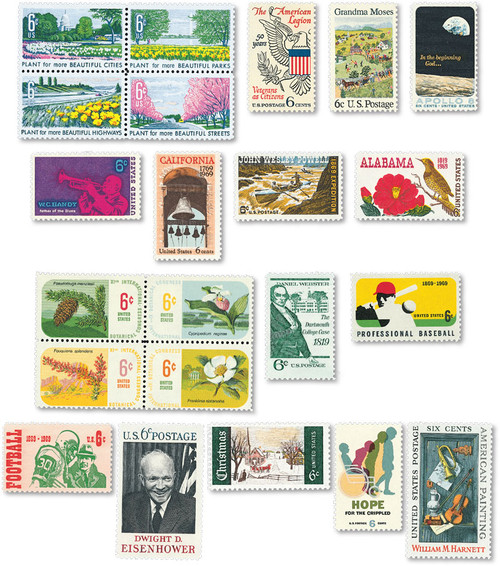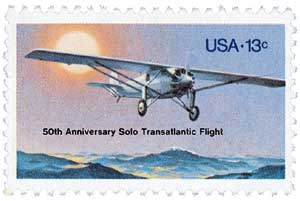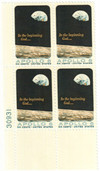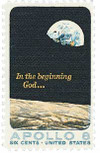
# 1371 - 1969 6c Apollo 8 Moon Orbit
Issue Date: May 5, 1969
City: Houston, TX
Quantity: 187,165,000
Printed By: Bureau of Engraving and Printing
Printing Method: Giori Press
Perforations: 11
Color: Black, blue and ocher
This stamp honors Apollo 8, which was launched from Cape Kennedy, Florida on December 21, 1968. The goal of the mission was to put astronauts in orbit around the moon, and advance toward the eventual goal of landing on the moon.
Launch Of Apollo 8
This mission was the second manned spaceflight mission in the Apollo program, and the first to leave low Earth orbit, travel around the moon and safely return to Earth. It was also the first human spaceflight launched from Kennedy Space Center.
The mission was originally planned for early 1969 but was moved up to December 1968 because the more ambitious lunar orbiter that was supposed to launch first wouldn’t be ready in time. As a result, the crew had two to three months less training than they had expected. The astronauts that would go on the mission were Frank Borman, James A. Lovell, Jr., and William Anders.
On the night before their launch, the crew had a special visitor – Charles Lindbergh, who’d famously flown solo across the Atlantic Ocean 41 years earlier. Lindbergh had asked how much fuel the rocket needed to get into space and was told 20 tons per second. He then smiled and said to the astronauts, “In the first second of your flight tomorrow, you’ll burn 10 times more fuel than I did all the way to Paris.”

The following day at 12:51 pm, the crew became the first to launch into space aboard the Saturn V rocket. Once in earth’s orbit, they performed the necessary checks and then received the “go” from NASA to head toward the moon. Getting the craft into lunar orbit was difficult, but the crew was able to do it on schedule.

Shortly after entering the moon’s orbit on Christmas Eve, the crew shared what they saw with the world through a public broadcast. One astronaut called the moon a “vast, lonely, forbidding type of existence,” while another mentioned Earth’s “grand ovation to the vastness of space.” After that, they took turns reading passages from the Bible. That television broadcast was the most watched TV event up to that time.

Shortly after the readings, the crew happened to see the Earth rising above the moon. No one had thought to take photographs of the Earth part of the mission. However, the crew recognized the importance of preserving this sight for all mankind and snapped the amazing photograph that appears on the stamp above.
Beginning their return trip after emerging from the far side of the moon, one of the astronauts called out on Christmas morning, “Please be informed, there is a Santa Claus.” The Apollo 8 returned home safely on December 27.
The success of Apollo 8 was a major stepping-stone in the Apollo program. Apollo 10 would bring a lunar lander close to the moon’s surface to simulate a landing, and Apollo 11 would land the first men on the moon. Today, the Apollo 8 spacecraft is on display at the Chicago Museum of Science and Industry.
Click here for more info and images about the Apollo 8 mission.
Issue Date: May 5, 1969
City: Houston, TX
Quantity: 187,165,000
Printed By: Bureau of Engraving and Printing
Printing Method: Giori Press
Perforations: 11
Color: Black, blue and ocher
This stamp honors Apollo 8, which was launched from Cape Kennedy, Florida on December 21, 1968. The goal of the mission was to put astronauts in orbit around the moon, and advance toward the eventual goal of landing on the moon.
Launch Of Apollo 8
This mission was the second manned spaceflight mission in the Apollo program, and the first to leave low Earth orbit, travel around the moon and safely return to Earth. It was also the first human spaceflight launched from Kennedy Space Center.
The mission was originally planned for early 1969 but was moved up to December 1968 because the more ambitious lunar orbiter that was supposed to launch first wouldn’t be ready in time. As a result, the crew had two to three months less training than they had expected. The astronauts that would go on the mission were Frank Borman, James A. Lovell, Jr., and William Anders.
On the night before their launch, the crew had a special visitor – Charles Lindbergh, who’d famously flown solo across the Atlantic Ocean 41 years earlier. Lindbergh had asked how much fuel the rocket needed to get into space and was told 20 tons per second. He then smiled and said to the astronauts, “In the first second of your flight tomorrow, you’ll burn 10 times more fuel than I did all the way to Paris.”

The following day at 12:51 pm, the crew became the first to launch into space aboard the Saturn V rocket. Once in earth’s orbit, they performed the necessary checks and then received the “go” from NASA to head toward the moon. Getting the craft into lunar orbit was difficult, but the crew was able to do it on schedule.

Shortly after entering the moon’s orbit on Christmas Eve, the crew shared what they saw with the world through a public broadcast. One astronaut called the moon a “vast, lonely, forbidding type of existence,” while another mentioned Earth’s “grand ovation to the vastness of space.” After that, they took turns reading passages from the Bible. That television broadcast was the most watched TV event up to that time.

Shortly after the readings, the crew happened to see the Earth rising above the moon. No one had thought to take photographs of the Earth part of the mission. However, the crew recognized the importance of preserving this sight for all mankind and snapped the amazing photograph that appears on the stamp above.
Beginning their return trip after emerging from the far side of the moon, one of the astronauts called out on Christmas morning, “Please be informed, there is a Santa Claus.” The Apollo 8 returned home safely on December 27.
The success of Apollo 8 was a major stepping-stone in the Apollo program. Apollo 10 would bring a lunar lander close to the moon’s surface to simulate a landing, and Apollo 11 would land the first men on the moon. Today, the Apollo 8 spacecraft is on display at the Chicago Museum of Science and Industry.
Click here for more info and images about the Apollo 8 mission.











